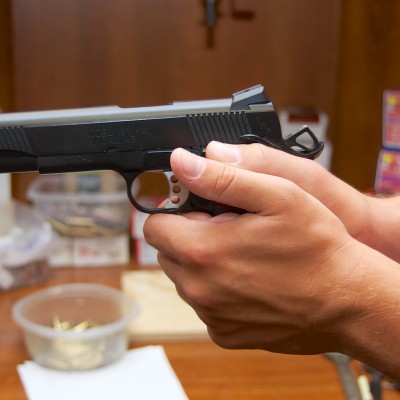This article originally appeared at OutdoorHub.
This week’s Seven Deadly Sins of Handgun Shooting Tip involves keeping (most) of your body parts attached.
Specifically, we’re talking about your thumbs. You see, opposable thumbs are one of the things that give us humans a real advantage over the rest of the animal kingdom when it comes to important things like opening Pringle’s cans and getting those straws into juice boxes without making a big mess.
Admittedly, the odds of actually slicing off one or more thumbs is fairly low, but the wrong thumb position may cause you to bleed all over the shooting range. We don’t recommend it. I can share this new-shooter tip from a vantage point of, ummm, let’s call it personal experience.
Remember Ghostbusters? And how it’s really bad to cross the streams of the Proton Pack particle accelerators
? Well there’s a similar rule of thumb (pun fully intended) for shooting semi-automatic pistols. Don’t cross your thumbs as in the picture. Sooner or later, that thing called a slide is going zoom backwards at Warp 17 and slice the dickens out of the webby, sensitive skin between your thumb and your index finger. Again, trust me, I know this from experience. And as a side note, the bottom of the slide on a Series 1 Colt Woodsman is really, really sharp. Just as a disclaimer, this happened a really long time ago – back when I thought I did not need any instruction on how to properly shoot a pistol. Don’t worry, I’ve learned many things the hard way since then.
Every time I go to the range, I see new shooters using the crossed-thumb grip with semiautomatic pistols. This presents a real dilemma. Do you walk over and interrupt like some kind of know-it-all and offer to help? Or do you let them learn the hard way? While they may not get thumb-reduction surgery that particular day, it’s bound to happen sooner or later. And lessons learned the hard way are the best right? Hmmm.

A grip like this one is much safer with a semiauto pistol.
Fortunately there’s an easy way to avoid bleeding all over your range. Don’t cross the streams. Point both thumbs forward and keep them on the weak hand side of your handgun. Your hand, and your local Doc In A Box, will thank you.
Since gun stuff is never simple or logical, there are some notable exceptions.
Since a revolver has no slide that zooms backwards, you don’t have to worry about getting cut. So technically there’s no harm in crossing that support hand thumb over the backstrap. In fact, if you look at how Jerry Miculek of Team Smith & Wesson grips a double-action revolver, he uses both styles. It’s hard to argue with Jerry’s grip choices as he shoots a revolver better than James Bond wears a dinner jacket
.
For larger revolvers with adequate grip and frame area, Jerry tends to keep both hands on the support side of the revolver, curled downwards–much like a semiautomatic pistol grip. For small revolvers, like a J-Frame, he actually crosses the support hand thumb behind his firing hand. Basically that is helping to support the backstrap–just on top of the shooting hand since there’s not much exposed backstrap area to work with.
Of course there’s another exception: single-action revolvers. Here’s where things get crazy. Those super fast cowboy action sheriffs and villains tend to use a the firing hand only to support the revolver. The support hand is actually somewhat disconnected and only serves to rapidly cock the hammer without disturbing the gun’s alignment in the firing hand grip. So with the single-action revolver, most cowboy action two-hand styles have the thumb crossing over the backstrap as well. Again, no matter since it’s a revolver. As a side note, if you haven’t seen some of the cowboy action shooters strut their stuff, watch a Single Action Shooting Society match sometime. It’s amazing what those folks can do with single-action revolvers.
As a rule of thumb (there’s that pun again) I simply teach new shooters to use a grip that keeps both thumbs on the inside–either curled downwards or pointed straight ahead towards the target. Once they break that natural tendency to cross thumbs over the backstrap you can start to introduce gun-specific variations.
Bottom line? Think about that grip. And what particular gun you’re shooting. Because bleeding all over the range is embarrassing.










One good thing: it happens only ONCE, as it is a lifelong lesson. Same applies to having fingers alongside a revolver’s cylinder.
When I donated my thumb I’m not sure what was worse: the pain, the mess, the embarrassment, or the cost in band aids 🙂
If you are shooting a da/sa revolver in single action mode, you can cock the hammer just a tad faster, if that is important, with your thumb wrapped over the holding hand. I watched a video of a very well known female shooter who was shooting a da/sa revolver and she was exceedingly slow in getting her left thumb back to the hammer to cock it. Mr. Miculek is a one-of-a-kind. He could probably shoot one-handed with his left hand in his trouser pocket and still get his left hand up to cock the piece faster than the rest of us take just to recover from the recoil of the shot. Some of who started decades ago shooting revolvers in NRA Handgun developed the habit of wrapping the left thumb over the right hand (for us right-handers) and even with the SA 1911, continued to do so, but always careful (after the first slice) to keep the thumb out of range of the slide. Inasmuch as I have now acquired a striker only firearm, I am learning new tricks.